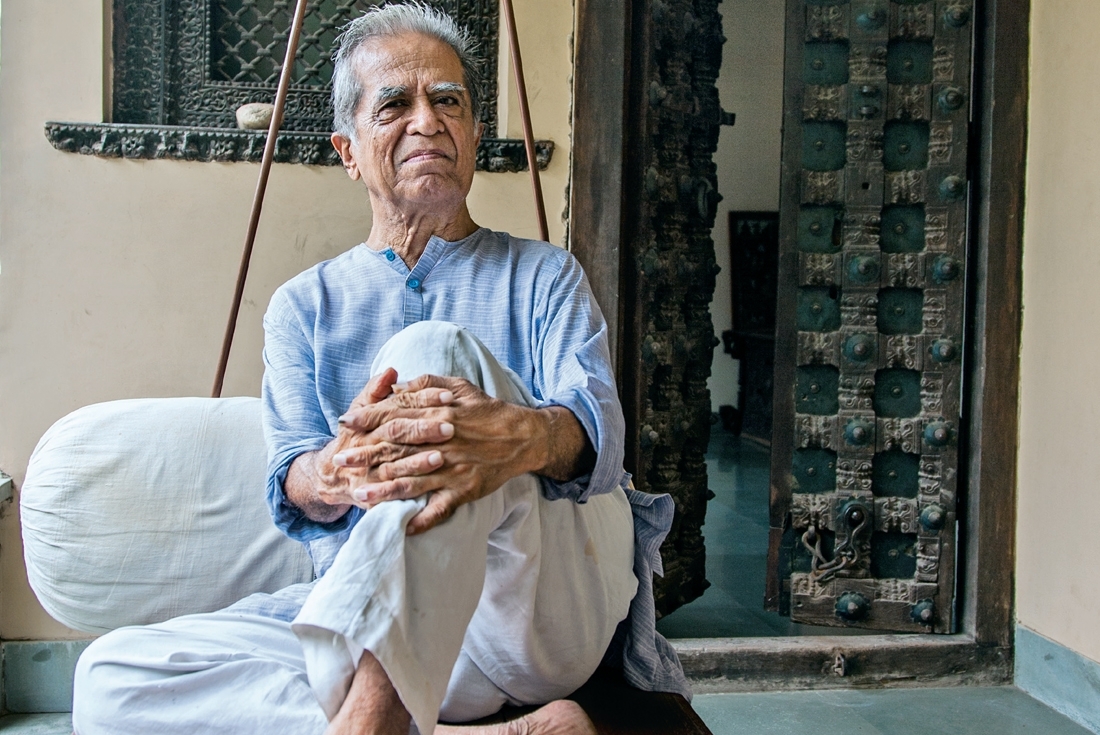

Haku Shah was there, at first light of everything we now know as ‘modern’ in India. He is not someone who will be called a designer in the way the suffix is used today, and that would not matter. As an artist, craftsman, humanist, educationalist, potter, designer and Gandhian, Haku Shah’s work over the decades has contributed vastly to defining what design is. We walk up to Hakubhai’s home, very close to the National Institute of Design in Ahmedabad on a rainy Saturday in July and wait for him in his studio amidst several paintings done by him through the years.
Would you like to talk about the birth of modern Indian design—the visit of the Eames’, Nakashima, Frutiger etc, and the influence of these men on Indian design? What was it like to have them as friends/ partners at work?
Both Charles [Eames] and George Nakashima used to come here to our home very often. Eames was the thinker, the logical designer. George was the maker, the artisan. He used to come, sit here, on this bed, the same way you are sitting now, and talk to me for a long time. Charles loved flying kites! When he came to Ahmedabad, he would come home, ask the kites to be taken out and go up to the terrace to fly them, while a whole battalion of people from NID would be looking at their watches, waiting for him downstairs to escort him to the next meeting. In his studio in Los Angles he had a pet octopus in a tank. When he was thinking, he would go sit near the tank and talk to it and touch the glass with the tips of his fingers. The octopus would touch the glass with its tentacles from the other side. He was working on a project with the acquarium and he found it important to live with one. He was very proud of his eight-limbed friend!
In your work—art, design, crafts—there were no walls between the various faculties. Things were built from the ground upwards. All that has changed now, post the ‘90s especially. Could you tell us about the life that was, when things were beginning?
I grew up in a small village in south Gujarat which was part of the tribal belt. Later, I taught at the Gandhi Ashram nearby. These influences made me look at things differently. Tribals use available resources, keeping in mind the environment, and it is something that comes naturally to them. Gandhi also believed in using things minimally and in being self-sufficient. These days in the West, there is lot of talk among designers and industries about the same things that were part of our lives. The saree became a cradle, got stitched into a bag or a quilt and in the end became a mop to clean. I call it re-incarnation, not recycling. Technology and markets bring changes very fast which are unnatural and unsustainable.
You were deeply involved with the revival of the arts and crafts in India right from the ‘60s. Could you talk a bit about that time? And how that period of revival influenced design as we know it today?
A whole variety of people were working with a lot of positive energy in the arts and crafts in India at that time—both Indians and people from outside the country. Synergies and interactions were important. There was no reason why an artist would not be involved with design, or a craftsman would not be interacting with researchers, for example. One important initiative was the setting up of the Weaver’s Service Centre which worked with weavers from across India and I was invited to work on this by Pupul Jayakar. K.G. Subramaniam, who taught me at the M.S. University, was also part of this. We worked on a lot of large exhibitions during those 15 or 20 years, like Unknown India which I curated with Dr. Stella Kramrisch of the Philadelphia Museum of Art. We set up a crafts village—the Shilpgram in Udaipur. We designed and curated a huge exhibition on clay: Maati Ye Tere Roop at the Crafts Museum in Delhi. One of the key factors in all this was understanding the importance of rituals and sanctity in the arts. It is also important to understand how they are deeply connected to people, earth and life.
What, in your view, has changed in arts, crafts and design today?
The artisan has a way of working, a certain logic and reason for why he does what he does. This has a profound connection to the world and is very spiritual. This is something that should not be disregarded. Design practice today has become a very different thing—a shadow of what it used to mean.
Would you have a word of advice for young designers?
Young people must study...they must look, observe and study. Rigour is important.
Painting has been very close to your work through these decades. I hear that you are planning an exhibition of your more recent paintings?
(Waves gently towards dozens of canvases stacked against the walls) I have been preparing for an exhibition of paintings on Gandhi this winter. It will be at the Gandhi Ashram in Ahmedabad.
Text Rukminee Guha Thakurta and Nityan Unnikrishnan